Martienssen W., Warlimont H. (Eds.). Handbook of Condensed Matter and Materials Data
Подождите немного. Документ загружается.


912 Part 4
spontaneous polarization in the crystalline regions. The
electric-field distribution is expected to be complex in
the thin film because of the interposition of the amor-
phous regions. A ferroelectric hysteresis loop can be
observed when the ratio of the volume of the crys-
talline regions to the total volume is relatively large
(e.g. more than 50%). The coercive field is larger (e.g.
> 50 MV/m) than that of solid ferroelectrics (usually
afewMV/m or smaller). The ferroelectric properties
depend sensitively upon the details of sample prepa-
ration, for example the use of melt quenching or melt
extrusion, the annealing temperature, or the details of
the poling procedure. Polymer ferroelectrics are useful
for soft transducers.
4.5.4 Physical Properties of 43 Representative Ferroelectrics
This section surveys the characteristic properties of
43 representative ferroelectrics with the aim of demon-
strating the wide variety in the behavior of ferroelectrics.
The 43 representative ferroelectrics are selected from
29 of the above-mentioned families. The presentation
is mainly graphical. Most of the figures are repro-
duced from LB III/36, where the relevant references
can be found. Table 4.5-2 summarizes the meaning
of the symbols frequently used in the figure cap-
tions and indicates the units in which the data are
given.
To facilitate to get more information on each repre-
sentative substance in LB II/36, the number assigned to
the substance in LB III/36 is given in parenthesis fol-
Table 4.5-2 Symbols and units frequently used in the figure captions
a, b, c unit cell vector, units Å
a
∗
, b
∗
, c
∗
unit cell vector in reciprocal space, units Å
−1
E
c
coercive field, units V/m
f frequency, units Hz = 1/s
P
s
spontaneous polarization, units C/m
2
T temperature, units K or
◦
C
κ dielectric constant (or relative permittivity) = ε/ε
0
, where ε is the permittivity of the
material and ε
0
is the permittivity of a vacuum. κ is a dimensionless number
κ
,κ
real and imaginary parts of the complex dielectric constant κ
∗
= κ
+iκ
.
κ
and κ
are both dimensionless numbers
κ
ij
component of dielectric-constant tensor; dimensionless numbers
κ
a
,κ
b
,κ
c
κ measured along a, b, c axes; dimensionless numbers
κ
(hkl)
κ measured perpendicular to the (hkl) plane; dimensionless number
κ
[uvw]
κ measured parallel to the [uvw] direction; dimensionless number
κ
T
κ of free crystal, i. e. κ measured at constant stress T; dimensionless number
κ
S
κ of clamped crystal, i. e. κ measured at constant strain S; dimensionless number
Θ
f
ferroelectric transition temperature, units K or
◦
C
lowing its chemical formula, e.g., KNbO
3
(LB number
1A-2).
4.5.4.1 Inorganic Crystals Oxides [5.1, 2]
Perovskite-Type Family
KNbO
3
(LB Number 1A-2). This crystal is ferroelec-
tric below about 418
◦
C. Further phase transitions
take place at about 225
◦
C and about −10
◦
C, re-
taining ferroelectric activity. The crystal has large
electromechanical coupling constants and is useful
in lead-free piezoelectric elements and SAW (surface
acoustic wave) filters in communications technology
(Fig. 4.5-13,4.5-14).
Part 4 5.4
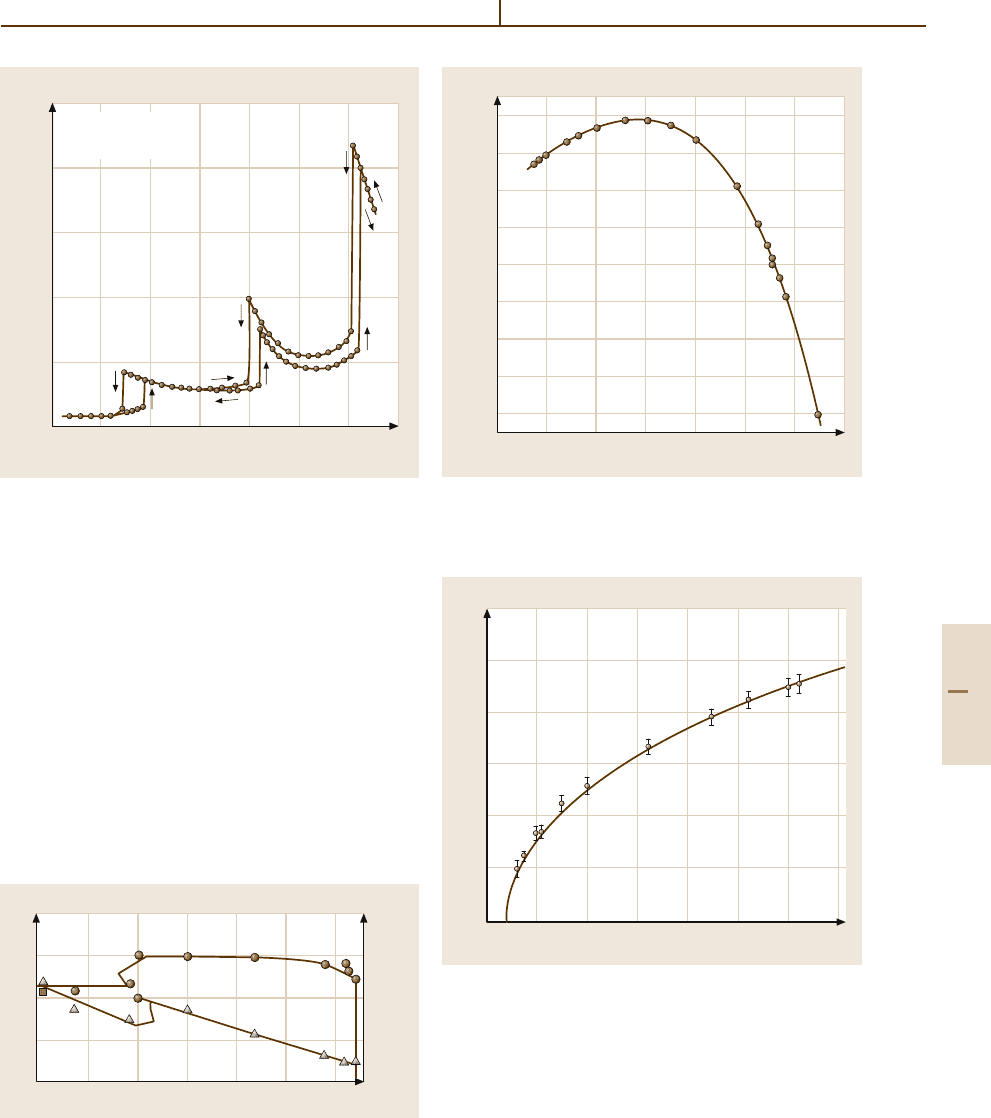
Ferroelectrics and Antiferroelectrics 5.4 Physical Properties of 43 Representative Ferroelectrics 913
5000
4000
3000
2000
1000
0
Dielectric constant
–200 –100 0 100 200 300 400 500
Temperature T (°C)
f = 10 kHz
E = 500 Vm
–1
Fig. 4.5-12 KNbO
3
. Dielectric constant κ versus tempera-
ture T
KTaO
3
(LB Number 1A-5). KTaO
3
is cubic at all tem-
peratures, and its dielectric constant becomes very
large at low temperatures without a phase transition
(Fig. 4.5-14). It is generally believed that this behavior is
related to the zero-point lattice vibrations. Replacement
of Nb by Ta generally lowers drastically the ferroelec-
tric Curie temperature , as seen by comparing Fig. 4.5-14
with Fig. 4.5-12. (This effect is well demonstrated later
in Figs. 4.5-39 and 4.5-40).
SrTiO
3
(LB Number 1A-8). This crystal is cubic at room
temperature and slightly tetragonal below 105 K. The
phase transition at 105 K is caused by softening of
the lattice vibration mode at the (1/2, 1/2, 1/2) Bril-
40
30
20
10
0
2000
1000
100 150 200 250 300 350 400
0
P
s
(10
–2
Cm
–2
) E
c
(10
2
Vm
–1
)
T (°C)
P
s
E
c
Fig. 4.5-13 KNbO
3
. P
s
and E
c
versus T . Measurements
were made by applying the electric field parallel to the
pseudocubic [100] direction
κ
3850
3845
3840
3835
3830
07123456
T (K)
Fig. 4.5-14 KTaO
3
. Real part of dielectric constant κ
ver-
sus T. f = 1kHz
ν
p
(10
12
Hz)
T (K)
100 240
1.50
120 140 160
1.25
1.00
0.75
0.50
0.25
0
180 200 220
Fig. 4.5-15 SrTiO
3
. ν
P
versus T. ν
P
is the frequency of the
R
25
(Γ
25
) optical phonon
louin zone corner (Fig. 4.5-15) without an appreciable
dielectric anomaly. At very low temperatures, the di-
electric constants become extraordinarily high without
a phase transition (Fig. 4.5-16), owing to softening of
the optical phonon at the origin of the Brillouin zone
(Fig. 4.5-17). It is generally believed that the absence of
a low-temperature transition is related to zero-point lat-
Part 4 5.4
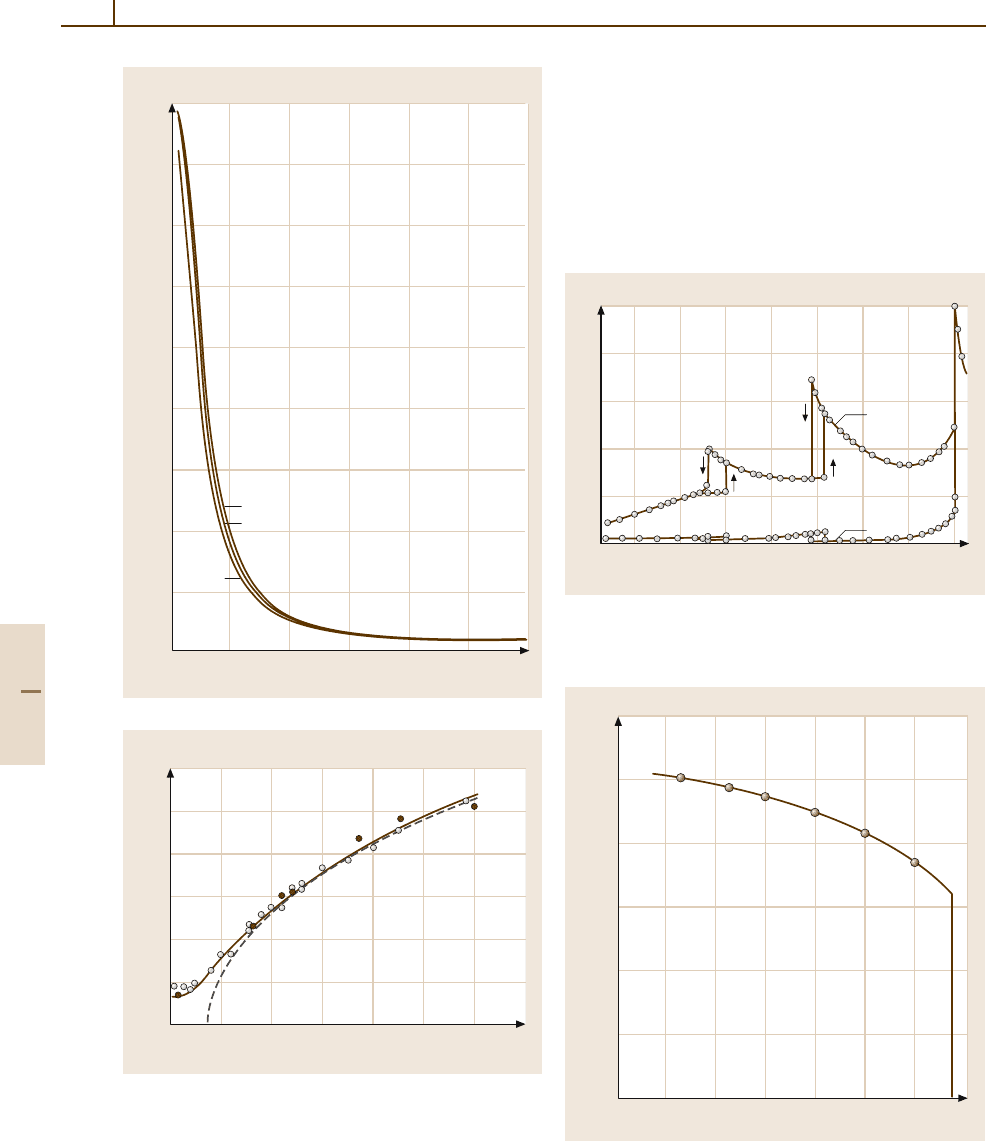
914 Part 4
T (K)
50
2.25
2.00
1.75
1.50
1.25
1.00
0.75
0.50
0.25
0
(10
4
)
100 150 200 250 300
(111)
(110)
(100)
0
κ
κ
κ
κ
50 kHz
ν
0
(10
12
Hz)
50
350
T (K)
3
2
1
0
100 150 200 250 300
0
Fig. 4.5-17 SrTiO
3
. ν
0
versus T . ν
0
is the frequency of
the soft phonon at q = 0. Open circles: inelastic neutron
scattering. Filled circles: Raman scattering. The solid curve
is 194.4 κ
1/2
and the dashed curve is 0.677(T −T
0
)
1/2
, with
T
0
= 38 K
Fig. 4.5-16 SrTiO
3
. κ
(111)
,κ
(110)
,andκ
(100)
versus T at
f = 50 kHz. κ
(111)
,κ
(110)
,andκ
(100)
are slightly different
from each other in the tetragonal phase
tice vibrations as in KTaO
3
. Solid solutions of SrTiO
3
are useful as ceramic thin films in memory devices.
(10
3
)
T (°C)
10
8
6
4
2
0
0 120
–160 –120 –80 –40 0 40 80
κ
a
c
κ
κ
Fig. 4.5-18 BaTiO
3
. κ
a
and κ
b
versus T . κ
a
and κ
b
are
the values of κ along the a and b axes, respectively, of the
tetragonal phase
0.30
0.25
0.20
0.15
0.10
0.05
0
200 40 60 80 100 120 140
T(°C)
P
s
(C m
–2
)
Fig. 4.5-19 BaTiO
3
. P
s
versus T in the tetragonal phase.
P
s
is parallel to the c axis
Part 4 5.4
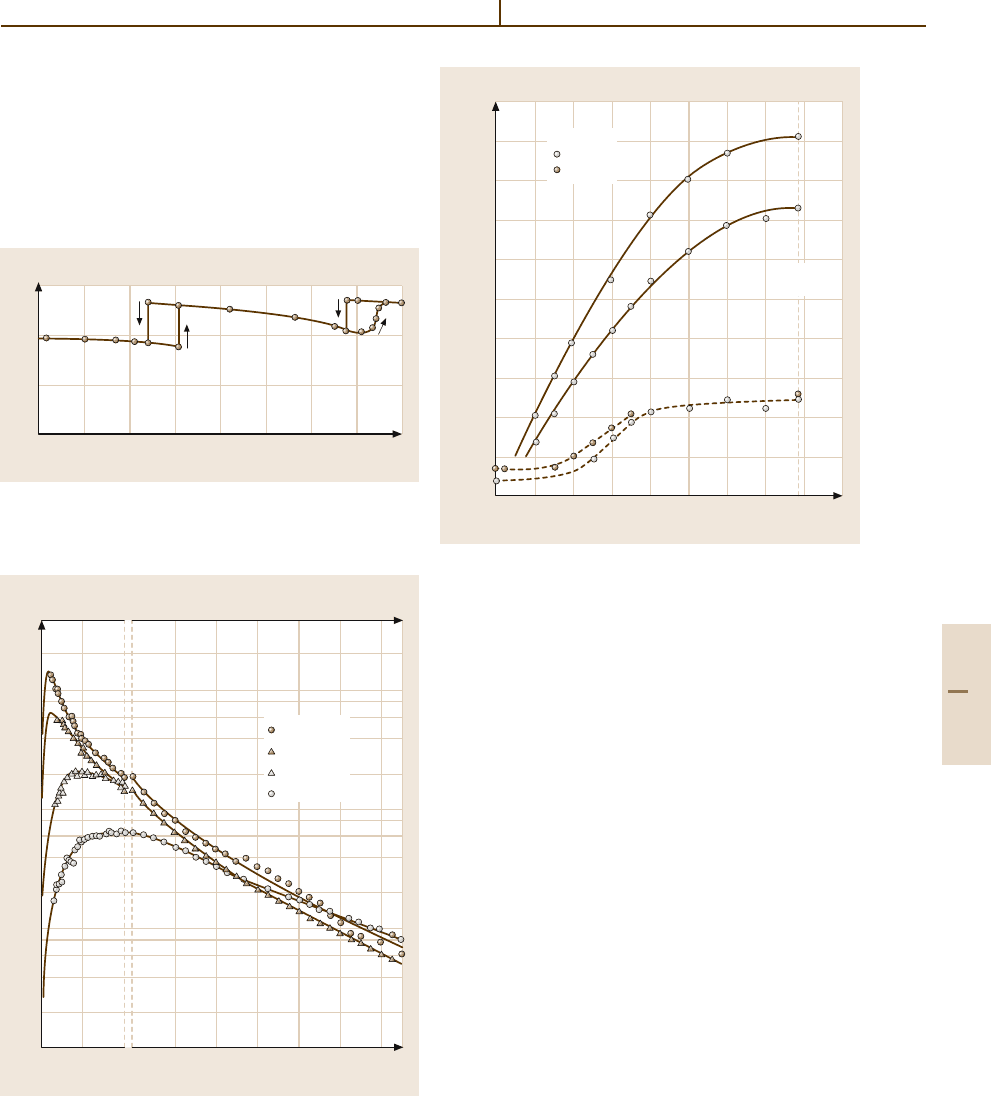
Ferroelectrics and Antiferroelectrics 5.4 Physical Properties of 43 Representative Ferroelectrics 915
BaTiO
3
(LB Number 1A-10). BaTiO
3
is the most exten-
sively studied ferroelectric crystal. It is ferroelectric
below about 123
◦
C, where the crystal symmetry
changes from cubic to tetragonal. Further phase transi-
tions take place from tetragonal to orthorhombic at about
5
◦
C and to rhombohedral at about −90
◦
C (Figs. 4.5-18
to 4.5-20). It is believed that the ferroelectric transition
30
20
10
0
–140 –120 –100 –80 –60 –40 –20 0 20
T (°C)
P
s
(10
–2
C m
–2
)
Fig. 4.5-20 BaTiO
3
. P
s[001]
versus T below 20
◦
C, where
P
s[001]
is the component of the spontaneous polarization
parallel to the c axis in the tetragonal phase
8
6
4
2
8
6
4
2
8
6
4
2
'' (arb. units)
40
10
10
–1
10
–2
ν/c (cm
–1
)
0 10 20 20 40 60 80 100
120 140
0 3 6 6 12 18 24 30 36 42
ν (10
11
Hz)
1
T = 408 K
T = 423 K
T = 473 K
T = 553 K
κ
Fig. 4.5-21 BaTiO
3
. κ
versus ν. Parameter: T . κ
is
the imaginary part of κ obtained from the hyper-Raman
spectrum. Curves: calculations based upon the classical
dispersion oscillator model. c: light velocity
4.840
3.872
2.904
1.936
0.968
0
0.1 0.2 0.3 0.4 0.5 0.6 0.7 0.8 0.90
ν (10
12
Hz)
ζ (Å
–1
)
[ζ 00]
Zone
boundary
T =
230 °C
430 °C
TA
LA
TO
Fig. 4.5-22 BaTiO
3
. Phonon dispersion relation deter-
mined by neutron scattering along the [100] direction in
the cubic phase. ν is the phonon frequency. LA, longitu-
dinal acoustic branch; TA, transverse acoustic branch; TO,
transverse optical branch. The frequency of the TO branch
is lower (softer) at 230
◦
C than at 430
◦
C, indicating mode
softening
is caused by softening of an optical mode at the center of
the Brillouin zone. Hyper-Raman scattering studies sup-
port this model (Figs. 4.5-21 and 4.5-22). The results of
neutron scattering studies favor this model (Fig. 4.5-23),
but the measurement was not easy owing to the intense
elastic peaks (Fig. 4.5-24a). These elastic peaks indicate
marked cluster formation in the vicinity of the Curie
point. As discussed in Sect. 4.5.3, there seem to be two
components contributing to the dielectric constant meas-
ured in the vicinity of the Curie point: a component due
to the soft mode and another one due to the motion
of the cluster boundaries. Presumably the two compo-
nents suggested by infrared and hyper-Raman scattering
data correspond to these two components. For theoreti-
cal studies of the phase transitions, readers should refer
to [5.7]. Solid solutions of BaTiO
3
are the most useful
ferroelectrics in ceramic condensers and as thin films in
memory devices.
When the temperature is raised above 1460
◦
C, cubic
BaTiO
3
performs another phase transition to a hexa-
gonal structure. This hexagonal phase can be quenched
Part 4 5.4
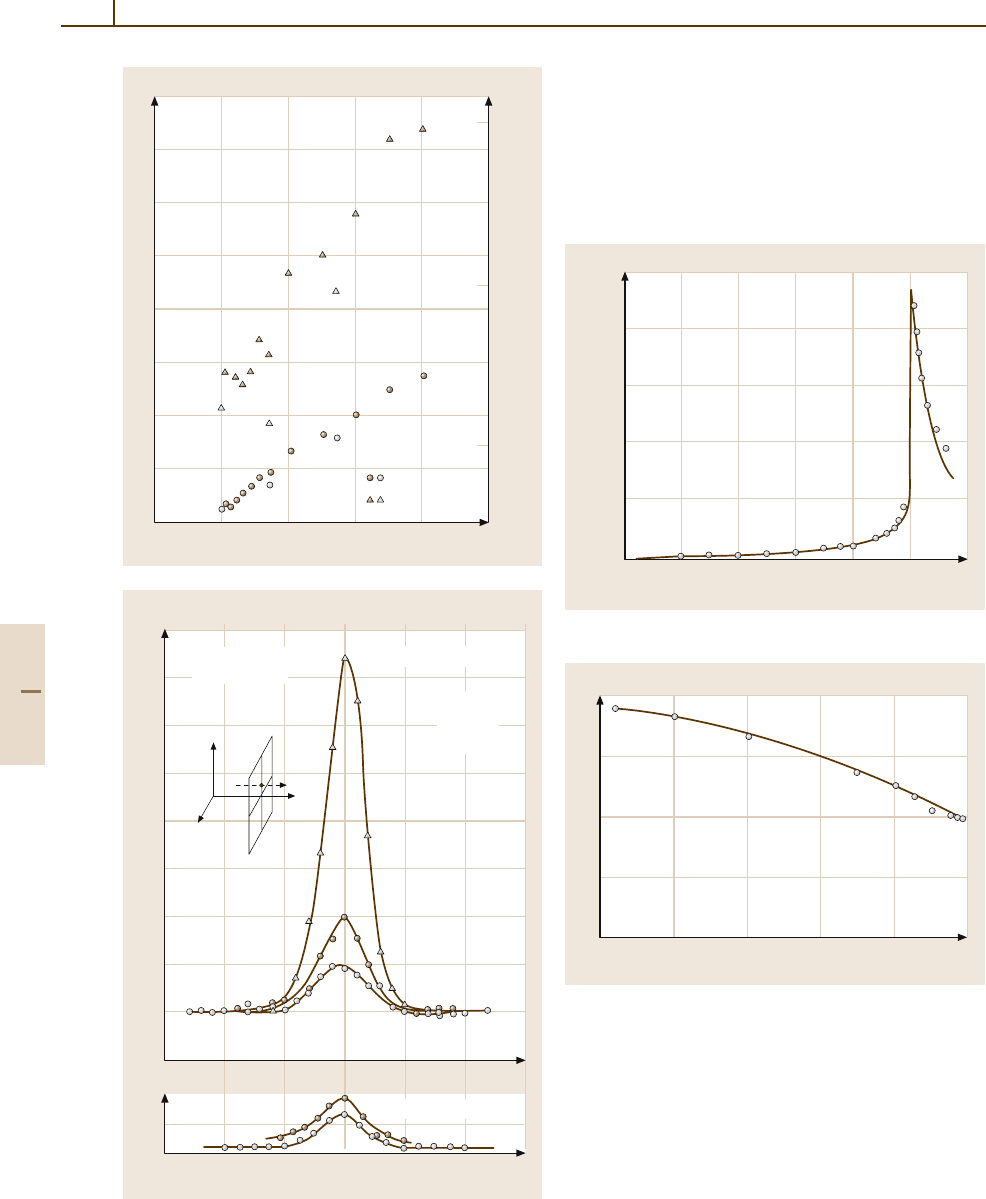
916 Part 4
T (K)
300
8
7
6
5
4
3
2
1
0
250
200
150
100
50
0
400 500 600 700 800
∆ν
0
, Γ (10
12
Hz) ∆ν
0
/c (cm
–1
)
∆ν
0
Γ
3.6
3.2
2.8
2.4
2.0
1.6
1.2
0.8
0.4
0
0.50
0.25
0
3.7 3.8 3.9 4.0 4.1 4.2 4.3
H
I (10
3
counts)
Cubic BaTiO
3
150 °C
Q = (H, K, O)a*
K = 0.1
K = 0.2
K = 0.3
ν = 0
K
L
H
ν = 0.97 ×10
12
Hz
b)
a)
Fig. 4.5-23 BaTiO
3
. ∆ν
0
and Γ versus T , obtained from
hyper-Raman scattering in the cubic phase. ∆ν
0
and Γ
are the optical mode frequency and damping constant, re-
spectively. The different symbols (brown and gray)show
results from different authors. ∆ν
0
decreases as the tem-
perature decreases to the Curie point, showing the presence
of mode softening. c: ligth velocity
10 000
8000
6000
4000
2000
0
0 100 200 300 400 500 600
κ
T (°C)
Fig. 4.5-25 PbTiO
3
. κ versus T
80
60
40
20
0
0 100 200 300 400
500
P
s
(10
–2
C m
–2
)
T (°C)
Fig. 4.5-26 PbTiO
3
. P
s
versus T
Fig. 4.5-24a,b BaTiO
3
. Triple-axis neutron spectrometer
scans at constant frequency across the sheet of diffuse scat-
tering at 150
◦
C. The path of the scans is shown in the
inset.
(a) shows the elastic scan (ν = 0), where the high
background level is due to nuclear incoherent scattering.
(b) Ineleastic scan (ν = 0.97 ×10
12
Hz)
Part 4 5.4
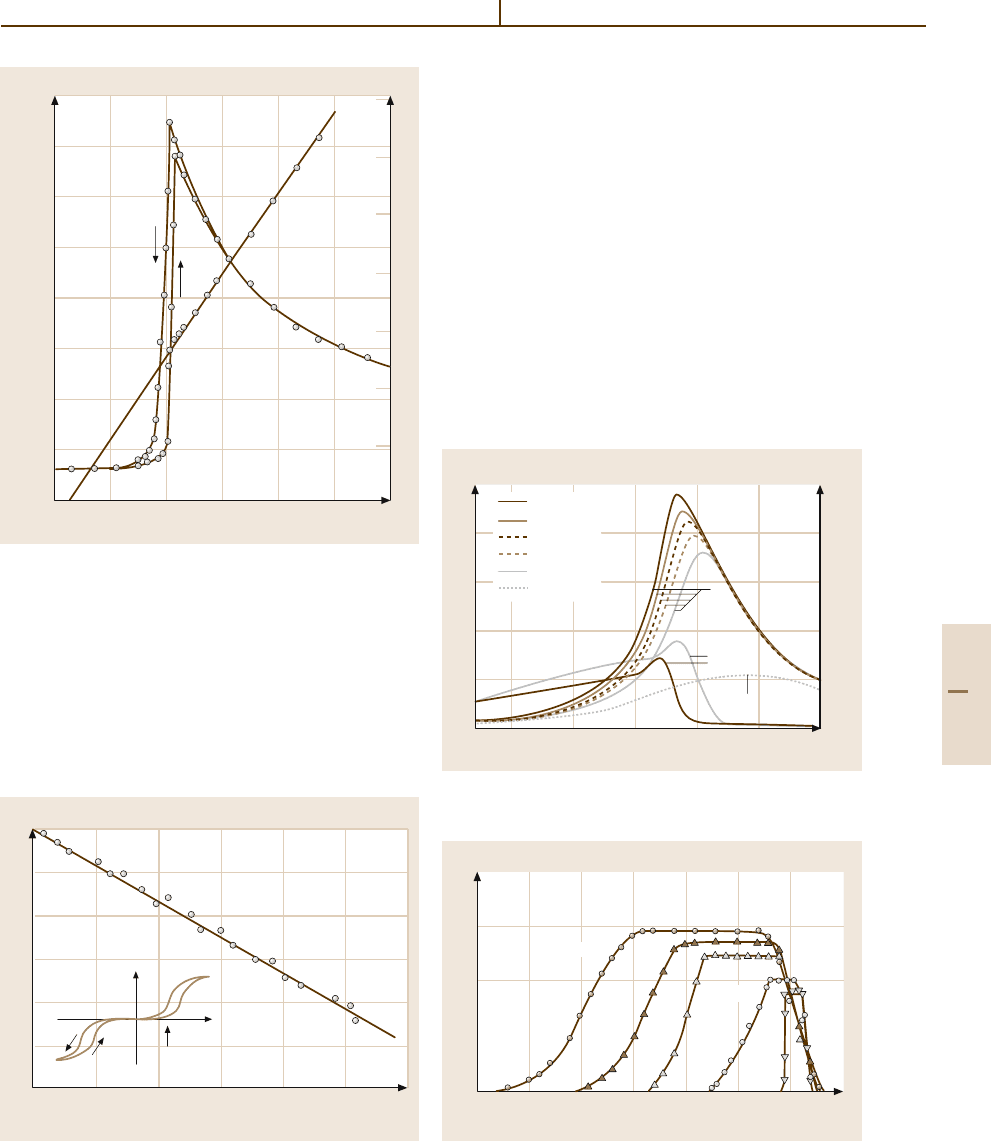
Ferroelectrics and Antiferroelectrics 5.4 Physical Properties of 43 Representative Ferroelectrics 917
4000
3500
3000
2500
2000
1500
1000
500
0
7
6
5
4
3
2
1
0
175 200 225 250 275 300 325
κ
c
κ
κ
T (°C)
f = 1 MHz
–1
c
(10
–4
)
c
–1
c
P
κ
Θ
Fig. 4.5-27 PbZrO
3
(single crystal). κ
c
and κ
−1
c
versus T
to room temperature by relatively rapid cooling. This
hexagonal BaTiO
3
also shows ferroelectric activity be-
low −199
◦
C.
PbTiO
3
(LB Number 1A-11). This crystal is ferroelec-
tric below about 500
◦
C (Figs. 4.5-25, 4.5-26). The
spontaneous polarization is large (Fig. 4.5-26) and
thus the pyroelectric coefficient is large, which makes
60
50
40
30
20
10
0
E
crit
(10
5
V m
–1
)
200 205 210 215 220 225 230
E
crit
E
P
T (°C)
Fig. 4.5-28 PbZrO
3
. E
crit
versus T. E
crit
is the critical field
of the antiferroelectric hysteresis loop
the crystal useful in infrared sensors. Solid solutions
with other perovskite-type oxides provide good dielec-
tric and piezoelectric materials (see PZT, PLZT, and
(PbTiO
3
)
x
(Pb(Sc
1/2
Nb
1/2
)O
3
)
1−x
below).
PbZrO
3
(LB Number 1A-15). This crystal is antiferro-
electric below about 230
◦
C (Fig. 4.5-27), exhibiting
a typical antiferroelectric hysteresis loop (Fig. 4.5-28).
Solid solutions of this substance are very important in
technological applications (see PZT and PLZT below).
Pb(Mg
1/3
Nb
2/3
)O
3
(LB Number 1B-d4). This crystal
exhibits a broad ferroelectric phase transition with
an average transition temperature of −8
◦
C deter-
mined by the maximum of the low-frequency dielectric
constant. A marked frequency dispersion of the
20
16
12
8
4
0
0.16
0.08
0
–150 –100 –50 0 50 100
T (°C)
100
2
10
60
600
1
Hz
kHz
kHz
kHz
kHz
MHz
δtan
κ
(10
–3
)
δ
tan
κ
κ
Fig. 4.5-29 Pb(Mg
1/3
Nb
2/3
)O
3
(ceramic). κ and tan δ ver-
sus T. Parameter: f
20
15
10
5
0
75
P
s
(10
–2
Cm
–2
)
100 125 150 175 200 225 250
T (°C)
x= 0.05
0.04
0.03
0.02
0.005
Fig. 4.5-30 Pb(Zr
1−x
Ti
x
)O
3
(ceramic). P
s
versus T .Pa-
rameter: x
Part 4 5.4
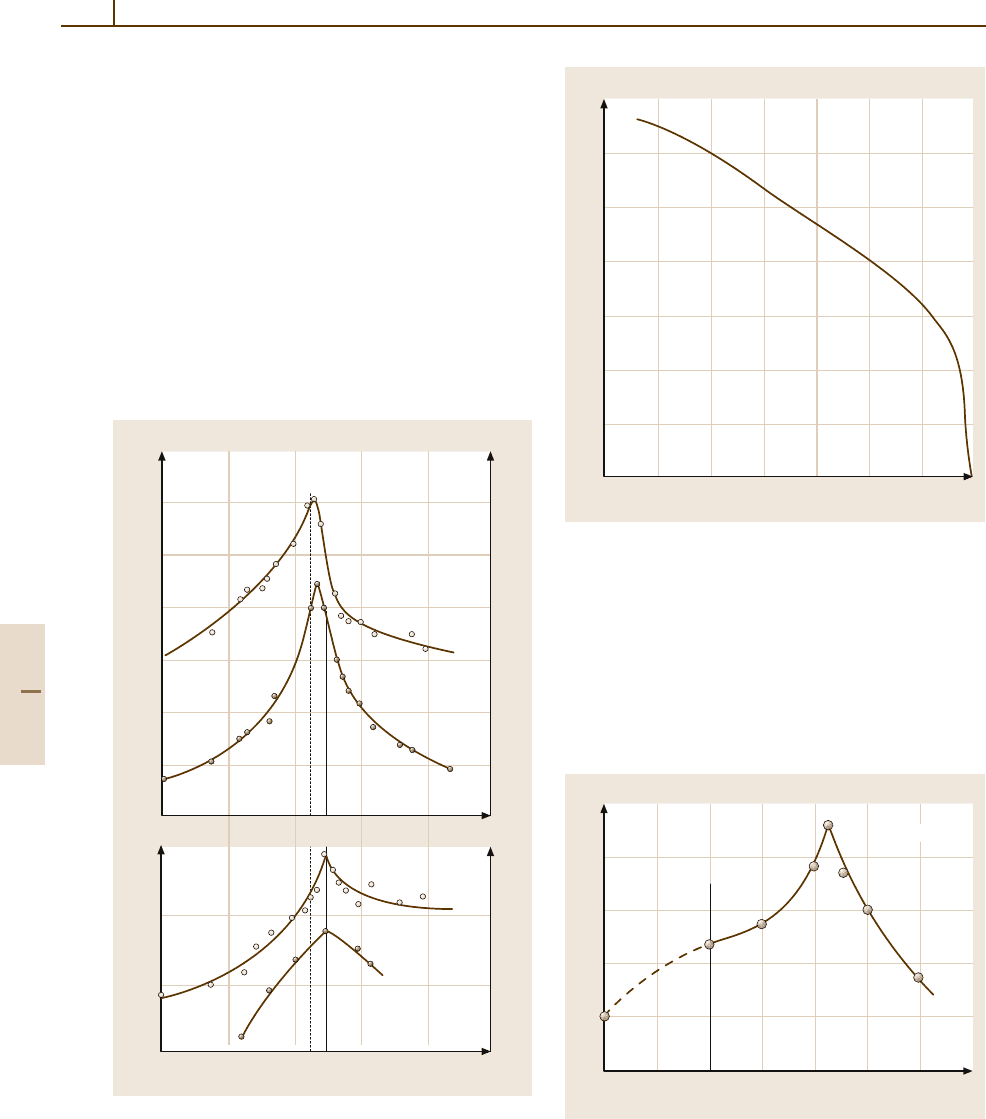
918 Part 4
dielectric constant occurs around the transition tem-
perature. These is a typical behavior of a relaxor
(Fig. 4.5-29).
Pb(Zr,Ti)O
3
(LB Number 1C-a62). PbZrO
3
is antiferro-
electric, as described above, while a small addition of
PbTiO
3
induces a ferroelectric phase (Fig. 4.5-30).
PZT (LB Number 1C-a63). Solid solutions
Pb(Ti
1−x
Zr
x
)O
3
with x = 0.5–0.6 are commonly called
PZT. They have very large electromechanical coupling
constants and are widely utilized as piezoelectric elem-
ents. Thin ceramic films are useful in memory devices
(Fig. 4.5-31).
1000
800
600
400
200
0
P
r
(10
–2
C/m
2
)
κ
p
i
(10
–4
C/(K m
2
))
– d
31
(10
–12
C/N)
x (PbZrO
3
)
100
80
60
40
20
0
45
35
25
15
4
3
2
1
0.3 0.4 0.5 0.6 0.7 0.8
d
31
P
i
P
r
Fig. 4.5-31 Pb(Ti
1−x
Zr
x
)O
3
2% Zr(Mn
1/3
Bi
2/3
)O
3
as an
additive (ceramic). κ, p
i
, d
31
,andP
r
versus x. p
i
is the py-
roelectric coefficient, d
31
is thepiezoelectric strain constant,
and P
r
is the remanent polarization (see Fig. 4.5-1)
0
35
30
25
20
15
10
5
0
P
s
(10
–2
C m
–2
)
–25 25 50 75 100 125125 150
T (°C)
Fig. 4.5-32 (Pb
0.92
La
0.08
)(Zr
0.40
Ti
0.60
)
0.98
O
3
(PLZT). P
s
versus T
PLZT (LB Number 1C-c66).
The acronym PLZT means
La-modified PZT. Hot-pressed ceramic PLZT is trans-
parent and useful for opticalswitches and similar devices
(Fig. 4.5-32).
(PbTiO
3
)
x
(Pb(Sc
1/2
Nb
1/2
)O
3
)
1−x
(LB Number 1C-b34).
These solid solutions have very large electromechan-
x (PbTiO
3
)
0.2 0.3 0.4 0.5 0.6 0.70.10
x = 0 corrsponds to Pb(Sc
1/
2
Nb
1/
2
)O
3
T = 25 °C
k
0.5
0.4
0.3
0.2
0.1
0
p
Fig. 4.5-33 (PbTiO
3
)
x
(Pb(Sc
1/2
Nb
1/2
)O
3
)
1−x
(ceramic).
k
p
versus x. k
p
is the planar electromechanical coupling
factor
Part 4 5.4
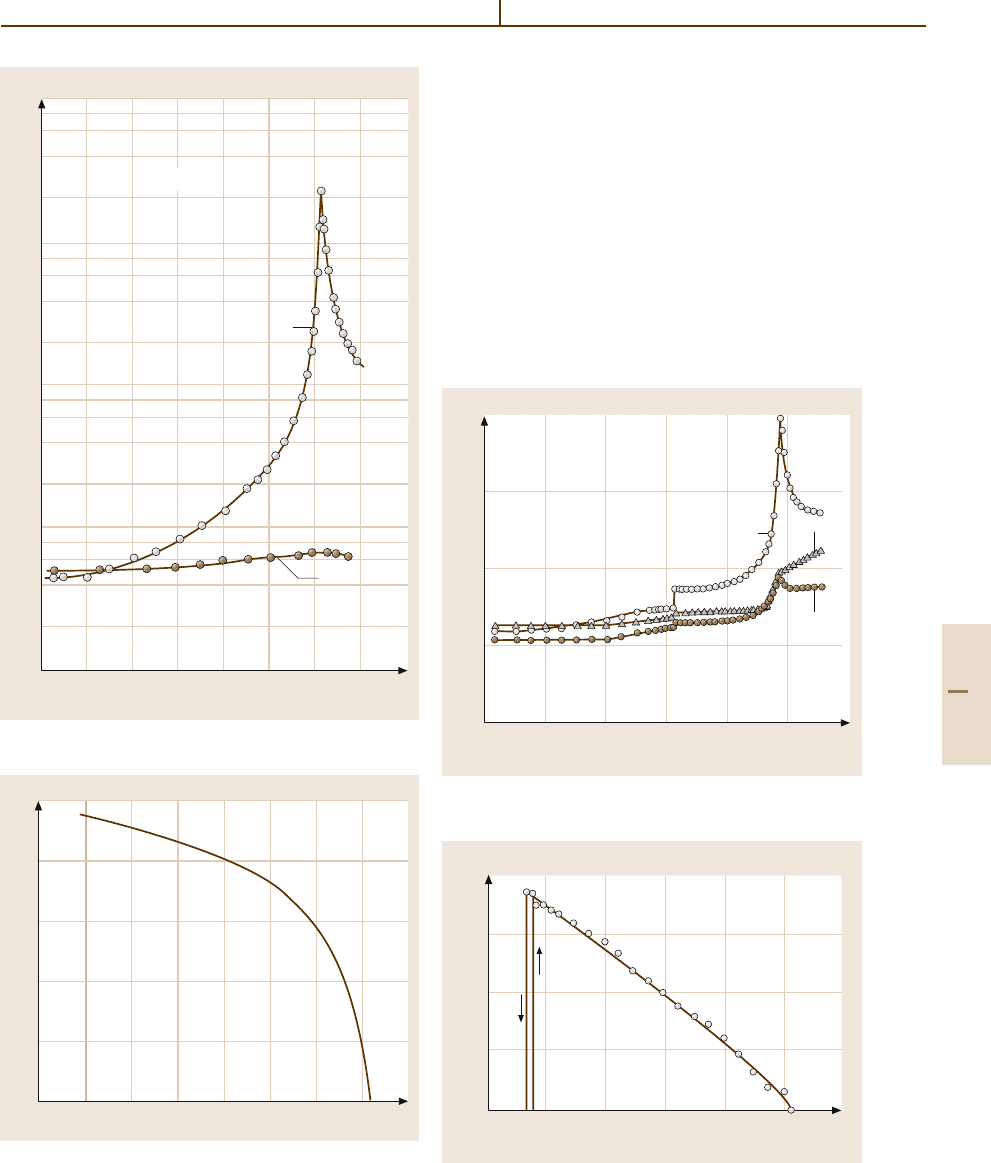
Ferroelectrics and Antiferroelectrics 5.4 Physical Properties of 43 Representative Ferroelectrics 919
8
6
4
2
8
6
4
2
10
4
10
5
6
4
2
10
3
6
4
2
10
2
8
8
10
0 100 200 300 400 500 600 700 800
κ
κ
T
T (°C)
T
κ
11
T
11
f = 10kHz
Fig. 4.5-34 LiTaO
3
. κ
T
11
and κ
T
33
versus T . f = 10 kHz
–100
1.0
0.8
0.6
0.4
0.2
0
0 100 200 300 400 500 600 700
T (°C)
P
s
/P
s
(0)
Fig. 4.5-35 LiTaO
3
. P
s
/P
s
(0) versus T. P
s
(0) is the value
of P
s
at 0 K (about 0.5Cm
−2
)
ical coupling factors, and are utilized for piezoelectric
actuators and similar devices (Fig. 4.5-33).
LiNbO
3
Family
LiTaO
3
(LB Number 2A-2). This crystal is ferroelectric
below 620
◦
C. The coercive field is large. The crys-
tal is useful for piezoelectric elements, for linear and
nonlinear optical elements, and for SAW filters in com-
munications technology (Figs. 4.5-34 and 4.5-35).
SrTeO
3
Family
SrTeO
3
(LB Number 4A-1). This crystal is ferroelectric
between 312 and 485
◦
C (Figs. 4.5-36 and 4.5-37).
0
10
4
10
3
10
2
10
1
100 200 300 400 500
600
κ
T (°C)
'
'
'
κ
T
22
κ
T
11
κ
T
33
Fig. 4.5-36 SrTeO
3
. κ versus T . f = 10 kHz
200
0.04
0.03
0.02
0.01
0
320 360 400 440 480 520
T (°C)
P
s
(C m
–2
)
Fig. 4.5-37 SrTeO
3
. P
s
versus T
Part 4 5.4
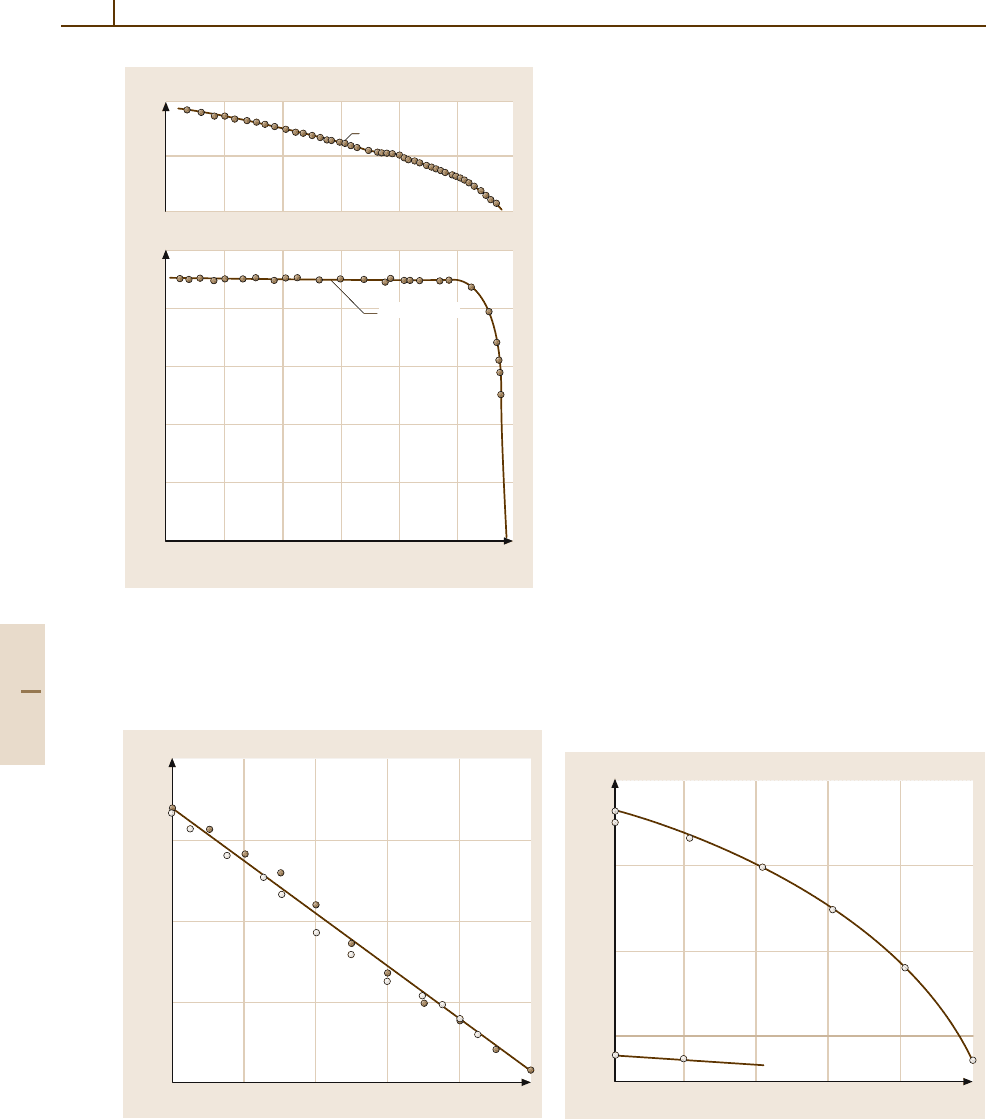
920 Part 4
d
33
(relative)
0
3.5
3.0
2.5
50
40
30
20
10
0
100
200
300
400
500
600
l
33
(10
–5
m)
T (°C)
l
33
d
33
(relative)
Fig. 4.5-38 Ba
2
NaNb
5
O
15
. d
33
and l
33
versus T . d
33
is the
nonlinear optical susceptibility (relative value), and l
33
is
the coherence length
Θ (K)
x
0.0
1000
750
500
250
0
0.2 0.4 0.6 0.8 1.0
Fig. 4.5-39 Ba
2
Na(Nb
1−x
Ta
x
)
5
O
15
. Ferroelectric transi-
tion temperature Θ versus x. Brown circles and gray circles
represent data measured by different authors
Tungsten Bronze-Type Family
Ba
2
NaNb
5
O
15
(BNN) (LB Number 6B-a7). This crystal is
ferroelectric below about 580
◦
C. The crystal structure
is modulated below 300
◦
C. This material is utilized
for optical second-harmonic generation and in optical
parametric oscillators (Fig. 4.5-38).
Ba
2
Na(Nb
1−x
Ta
x
)
5
O
15
(BNNT) (LB Number 6C-b30). The
transition temperature varies over a wide temperature
range as x varies from 0 to 1.0 (Fig. 4.5-39).
Sr
2
Nb
2
O
7
Family
Sr
2
(Nb
1−x
Ta
x
)
2
O
7
(LB Number 8B-6). These solid solu-
tions can be made over the whole range of x = 0–1.0,
and the Curie point varies over a wide temperature range
from 1342
◦
Cto−107
◦
C (Fig. 4.5-40). The solid so-
lutions are very useful as high-temperature dielectric
materials, especially because they do not contain Pb,
which is volatile at high temperatures.
Li
2
Ge
7
O
15
Family
Li
2
Ge
7
O
15
(LB Number 13A-1). This crystal is ferroelectric
below 283.5 K. The sign of the spontaneous polarization
is reversed around 130 K (Figs. 4.5-41 and 4.5-42).
GMO (Gd
2
(MoO
4
)
3
) Family
Gd
2
(MoO
4
)
3
(GMO) (LB Number 17A-3). Three crys-
tal structures of GMO are known, α, β,andγ . The
β structure is stable above 850
◦
C but can be ob-
tained at room temperature as a metastable state by
Θ (°C)
x
0 1.0
1500
1000
500
0
0.2 0.4 0.6 0.8
–273
Θ
f
Fig. 4.5-40 Sr
2
(Nb
1−x
Ta
x
)
2
O
7
. Ferroelectric transition
temperature Θ
f
versus x.Thelower curve shows another
phase transition temperature
Part 4 5.4
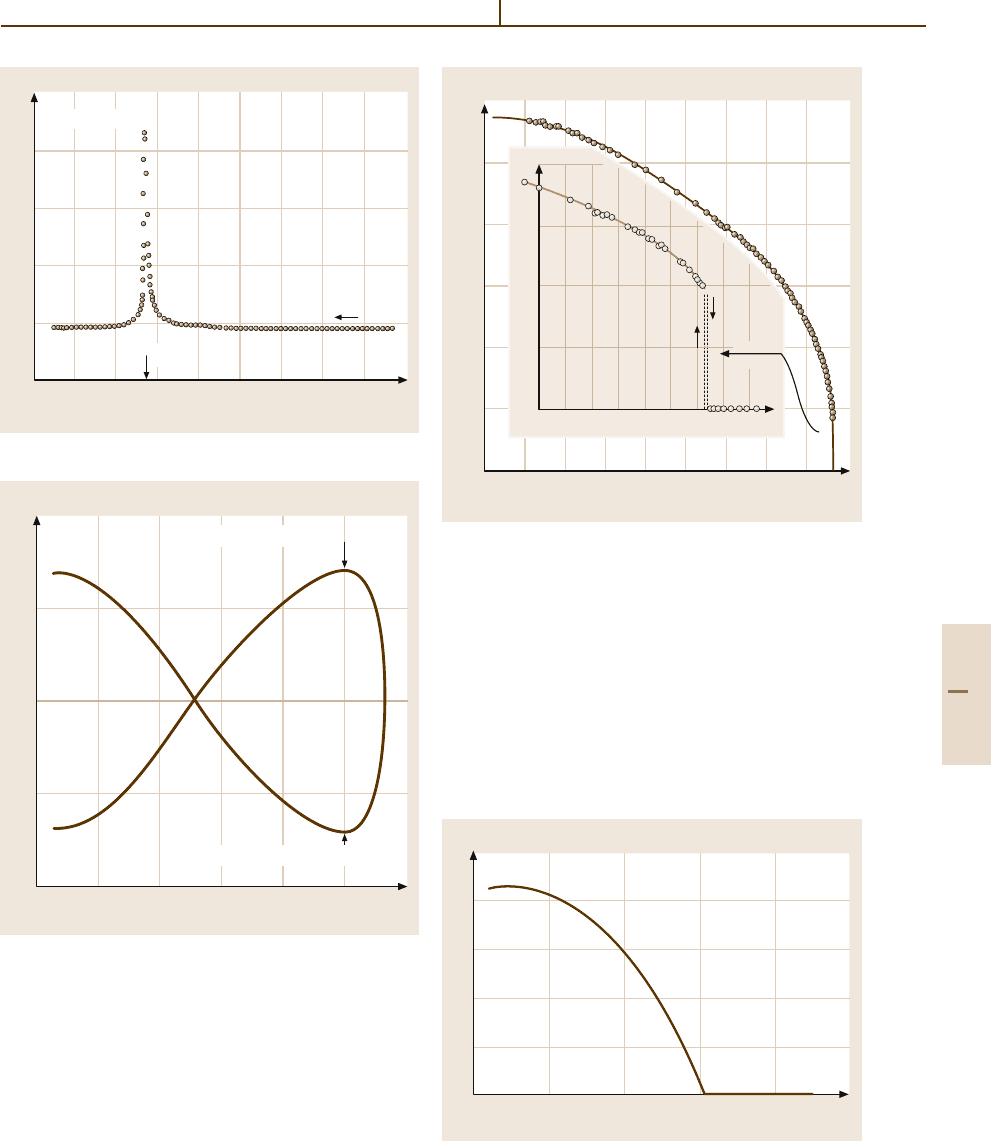
Ferroelectrics and Antiferroelectrics 5.4 Physical Properties of 43 Representative Ferroelectrics 921
κ
270 315
50
40
30
20
10
0
275 280 285 290 295 300 305 310
c
Θ
f
T (K)
f =10 kHz
Fig. 4.5-41 Li
2
Ge
7
O
15
. κ
c
versus T . f = 10 kHz
50
25
0
–25
–50
0 50 100 150 200 250 300
T (K)
P
s
(10
–5
C m
–2
)
E
bias
= 420 kV m
–1
E
bias
= – 420 kV m
–1
Fig. 4.5-42 Li
2
Ge
7
O
15
. P
s
versus T . P
s
was determined
by pyroelectric-charge measurement
rapid cooling. Ferroelectric activity takes place in this
metastable β-GMO below 159
◦
C. The phase transi-
tion is the indirect type III
op
discussed in Sect. 4.5.3.
The dielectric constant of the clamped crystal (κ
S
c
in
Fig. 4.5-6) shows no anomaly at the transition point.
The ferroelectric phase results from a phonon insta-
bility at the (1/2, 1/2, 0) Brillouin zone corner of the
parent tetragonal phase. Anharmonic coupling to the
T (K)
0 450
0.30
0.25
0.20
0.15
0.10
0.05
0
P
s
(10
–2
Cm
–2
)
50 100 150 200 250 300 350 400
426
P
s
(10
–2
Cm
–2
)
T (K)
0.08
0.06
0.04
0.02
0
428 430 432 434
Near the
transition
Fig. 4.5-43 Gd
2
(MoO
4
)
3
. P
s
versus T
resulting antiparallel displacements produces a spon-
taneous strain, which in turn causes a spontaneous
polarization through the normal piezoelectric coupling
(Fig. 4.5-43).
Boracite-Type Family
Ni
3
B
7
O
13
I (LB Number 18A-23). This crystal is
ferroelectric and ferromagnetic below about 60 K
(Figs. 4.5-44, 5-45, 5-46): a rare example where both fer-
roelectric and ferromagnetic spontaneous polarizations
0
75
60
45
30
15
0
20 40 60 80
100
T (K)
P
s
(10
–5
Cm
–2
)
Fig. 4.5-44 Ni
3
B
7
O
13
I. P
s
versus T . P
s
was measured
with the specimen parallel to the cubic (001) plane
Part 4 5.4
